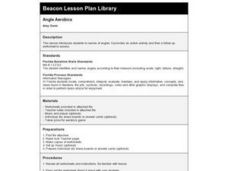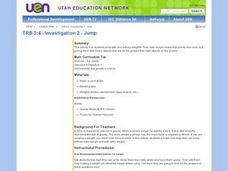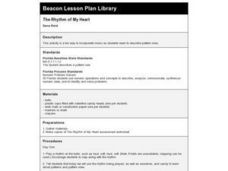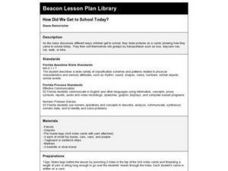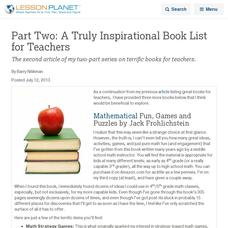Curated OER
"ty" number
Second graders encounter the need to assess the code in English for tens is that the word ends in "-ty." They explore the meaning of two or three digit whole numbers to realize that the meaning of words like sixty can be decoded by...
Curated OER
Calculator Numbers
Third graders practice working out a hidden number on a calculator via number sequence in the advanced additive stage six. They assess number sequence to unveil a mystery number that has been entered onto a calculator and then switch...
Curated OER
Class Number Book
Students practice counting by ones. They find the numbers one through ten in a magazine or catalog. They put their picture into a classbook and they use it to practice counting.
Curated OER
"YIKES! Your Body Up Close" by Mike Janulewicz
Students use a Venn Diagram to analyze data from their class.
Curated OER
The Achievements and Challenges of Guatemala
Students research the Mayan number and calendar system. They translate a variety of math problems from base-10 Arabic numbers into a base-20 Mayan representation. They discuss current challenges faced by the people in today's Guatemala.
Curated OER
Angle Aerobics
Third graders review angle criteria and then stand. They demonstrate with their hands each type of angle called out by the teacher: right, acute, or obtuse. Music is added and students follow teacher in an angle aerobics class peppered...
Curated OER
Wheeling Around
Eighth graders explore the characteristics of a circle and the formulas to find circumference. They use a bicycle wheel to determine the circumference around a wheel. They utilize a worksheet imbedded in this plan which has a variety of...
Curated OER
Sample This
Learners gain a greater understanding of how statistical samples are conducted by taking polls of specific populations. These polls be expressed in graphs, which be compared with the same questions asked of other populations.
Curated OER
Area Lesson Plan
Students manipulate a variety of materials and computer applets in order to explore area and the units used to measure it.
Curated OER
Richard's Dice
Students problem solve logic problems. They complete a worksheet using dice as a manipulative. They decide on a problem solving strategy, solve the problem, and write up the solution.
Curated OER
TRB 3:4 - Investigation 2 - Jump
Third graders jump with and without weights to reveal data that gravity has more of a pulling force with heavy objects that are on the ground than light objects on the ground. They also identify how their legs felt when they jumped with...
Curated OER
The Letter "L"
Students practice using the letter "L." In this letter "L" lesson plan, students complete a worksheet (not included) on which they identify pictures of items that begin with the letter "L."
Curated OER
Taking In The Heat
Students discover that different textured materials can absorb more heat than others. Students work with thermometers, clocks, and graphs.
Curated OER
The Rhythm of My Heart
First graders describe pattern rules. They use the rhythm being played on a bell and candy hearts to explore patterns and pattern rules. This is an especially good lesson to use around Valentine's Day.
Curated OER
Raising the Bar While Hogging the Ham (Radio That Is)
Students create a bar graph that communicates an amount without the need to know the exact data, determine what scale to use to best represent the data and use their bar graph to persuade others.
Curated OER
How tall are you?
Students review different units of measurement that would be used to measure height. They compare their height to that of Abraham Lincoln by working with a partner to make a life size tracing of each other and measuring their height.
Curated OER
What is the Relationship Between Radioactivity and Radon?
Students examine the relationship between radioactivity and radon. They practice using a geiger counter with different materials. They answer questions to complete the lesson.
Curated OER
"Working in a Hat Factory"
Students analyze the understanding of what a producer is. Students distinguish between producers and consumers. Students produce a hat of his/her own. Students will share creations with each other.
Curated OER
Design an Apartment
Young scholars are given the task of designing an apartment. In groups, they practice estimating the area and perimeter of different shapes. After designing their space, they apply the same formulas to solving real-world story problems.
Curated OER
On the Oregon Trail
Students prepare cross-curricular lessons based on the experience of traveling the Oregon Trail.
Curated OER
Part Two: A Truly Inspirational Book List for Teachers
The second article of my two-part series on terrific books for teachers.
Visa
Nothing But Net: Understanding Your Take Home Pay
Introduce your young adults to the important understanding that the money they receive from their paychecks is a net amount as a result of deductions from taxes. Other topics covered include federal, state, Medicare and social...
Curated OER
ABC and 1-2-3 Farming
Students demonstrate how to alphabetize animal names. In this word study lesson, students identify animals that live on the farm and conduct a favorite farm animal survey. Students order animal pictures in alphabetical order.







